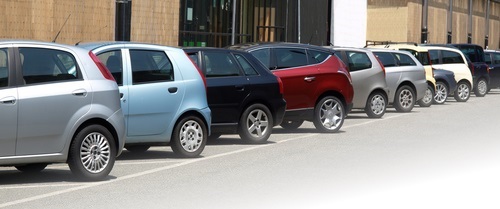Parallel parking
Parallel parking means parking your car in line with the other cars parallel to the curb, front bumper to rear bumper. Parallel parking usually occurs on the side of streets where there are no parking facilities, because it leaves enough room for the traffic to pass. Parallel parking is a challenge to some people, because it requires a certain technique different than driving right into a parking space:

How to parallel park your car
With parallel parking, you first drive your car next to the car you're parallel parking on. This is the car that is in front of the open parking space you want to park your car. If the car that you’re parallel parking on is the same size, line your right side mirror up with their left side mirror. If the car is bigger, place your car a bit further back. If the other car is smaller, move a bit more towards the front of that car. Then you move back slowly, with the wheel turned towards the curb. At one moment, you turn the wheel away from the curb fast and keep driving backwards slowly. When the back of your seat is aligned with the rear bumper of the car you’re parallel parking on, turn the wheel away from the curb fast while keep moving back slowly. If everything went right, you have parked your car right between the two other cars now and close to the curb. Sometimes you need to adjust your position with moving back- and forward a bit. When parallel parking, you always have to make sure there is enough space left between the other cars and yours so that you’re all able to pull out of the parking space.
Perpendicular parking
Perpendicular car parking means parking the cars side by side, perpendicular to a wall, curb or something else. You see this type of parking mostly in parking bays and garages, because you can park many cars on limited space.
Angle parking
Angle parking is similar to perpendicular parking, except the cars are aligned in an angle. Normally the angle is aligned with the direction cars approach the parking space. It makes it a lot easier to drive into the parking space in contrast to perpendicular parking, where the parking space is at a 90 degree angle. With angle parking there is a gentler turn. Not only is it easier to park, but it’s also faster and the parking spaces are smaller, making it possible to add more parking spaces in the same size area. Normally you see angle paring inside parking garages and on streets that are wide enough to have room left for the traffic to pass.
Double parking
Double parking means that someone has parked their car in a certain way that prevents another car from departing. Double parking can happen in different situation:
Double parking on-street
This type of double parking is illegal and you can get fined for it. Double parking on-street means that you park your car parallel to a car that is parked next to the curb. Double parking in this situation means that the car parked next to the curb cannot depart because it is blocked by your car, and often your car also blocks the traffic flow. Unfortunately, double parking on-street is quite common in larger cities. Sometimes the people who double park their car even leave the hand break off so that people can push their car forward or backwards a bit if it blocks them.
Double parking in parking garages with attendees
In this situation, double parking is used to be able to park as many cars as possible in the parking garages. It’s a different situation than on-street, because in this situation the cars are parked by attendees (or valets). The attendee holds on to the keys of all cars. If one needs to get out and it’s block by another car, the attendee simply brings the keys to both cars and moves the car that blocks the other.
Parking on more than one parking space
The term “double parking” is sometimes also used to indicate the situation where a car parks over the lines that separate the parking spaces and therefor taking more than one parking space.



























